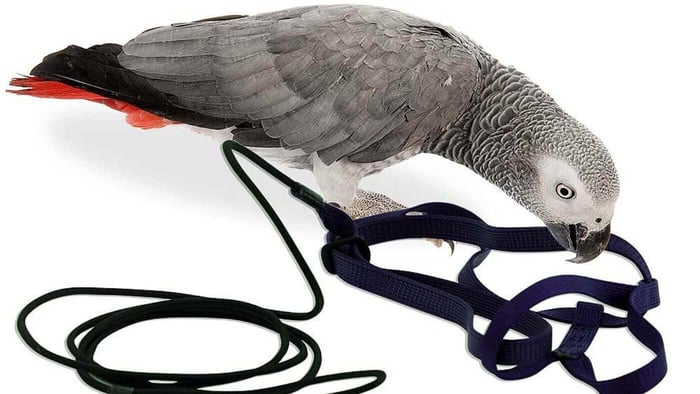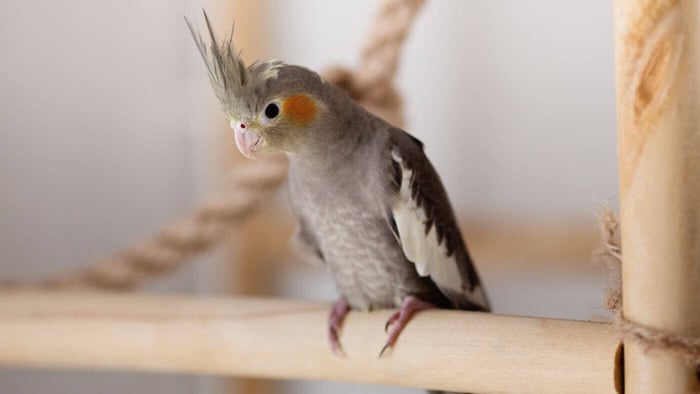Pet Parrot Care - Avoid Doing These 11 Things with Your Pet Parrot
Pet Parrot Care is a topic covered by many, and if you just got your first parrot or are just trying to continue learning, it can be difficult to figure out what's true and what isn't. There's an endless supply of advice out there about what you should avoid doing with your pet parrot, much of which should be taken with a pinch of salt.
To separate fact from fiction, we've compiled a list of our 11 ultimate pet parrot care 'don'ts' (in no particular order) based on our own experience and scientific research. Keep reading to find out what you definitely shouldn't be doing if you own a pet parrot!
1. Clipping your parrot's wings
The short version is that (partly) taking away your parrot's ability to fly, although still recommended in many places, is an outdated practice that can lead to many behavioural and even physical issues in your pet and it is a bad pet parrot care practice in our opinion.
Think about it: parrots are prey birds, and their entire feeling of safety is centred around their ability to take off in flight. Without this ability, they are in fear, even if there logically is no reason to be. Screaming and biting are right around the corner.
A bad wing clip can even lead to serious health issues in the case of a crash landing. Additionally, in the long run, the inability to fly can cause muscle atrophy and contribute to obesity.
2. Feeding a poor diet
Probably the absolute number one cause of premature death in parrots is diet: feeding the wrong food and overfeeding. You might literally end up cutting your parrot's lifespan in half if you don't feed your bird a healthy and balanced diet.
Parrot diet is another complex topic when it comes to pet parrot care, but in a nutshell, the biggest problem for most birds is a lack of variety and nutrients. The myth that a parrot can survive on a diet of just seed is still pervasive, and pet stores will often gladly tell you that this is all your parrot needs. It's not.
Whether you're a fan of using seed-based parrot food as a base or prefer a complete pelleted parrot diet, the key to doing it right in the long run is to add plenty of other foods. Veggies are a good option that's not too high in calories; fruits can be fed sparingly. But think beyond that: sprouts, cooked whole grains, and even common garden weeds like dandelion leaves bring plenty of micronutrients into your parrot's diet.
Of course, you should always make sure the seed or pellet brand you're feeding is high in quality. It should not contain added sugars or high levels of 'junk' food like sunflower seeds, dried fruit and whole nuts: those make great training treats but not a properly balanced diet.
You should keep in mind that your parrot is not as active in captivity as it would ever be in the wild. Overfeeding is a real danger, carrying with it the risk of obesity and related health problems. For more information about parrot feeding, read 'What Shall I Give My Parrot To Eat?'.
3. Keeping your parrot caged 24/7
Obesity is a huge silent killer of parrots. It's difficult to spot under all those feathers, and it can lead to a range of different diseases, just like it does in humans.
As discussed above, feeding a proper diet is one of the main keys to keeping your parrot healthy. However, another big factor in preventing obesity is, of course, exercise. And unless you can offer an aviary, your parrot can't exactly fly proper laps if it's kept in its cage 24/7. And even then, a huge enclosure can't replace out-of-cage time.
However, exercise is not the only reason your parrot shouldn't be caged all the time. These are birds of huge intelligence, and they have a constant drive to discover new things. Our (parrot-proofed) homes are a treasure trove of stimulation for them, as is being able to interact with us. A caged parrot is at risk of self-mutilation, feather plucking and incessant screaming.
A parrot kept in its cage all the time might become cage-bound. Cage-bound is a condition where parrots can feel safe only when inside their cage and no longer wish to come out of it. Cage-bound parrots can become extremely protective of their cage, sometimes attacking even if you're just changing the water.
4. Leaving your parrot unsupervised outside of its cage
We've just discussed how important it is to let your parrot spend plenty of time roaming outside of its cage. There's a catch, though: unless you have a dedicated bird room with no dangerous objects whatsoever, you can't leave the pet parrot unsupervised.
Parrots are incredibly curious and will want to explore everything, preferably with their beaks. An electricity cable? Great chewing toy. A forgotten glass? Gotta check what's inside. A weak point in the wall? Time to chew through that and make a nest inside. All fun and games until your companion parrot gets electrocuted, suffocates upside down in the glass, or gets lost between walls.
Even if you THINK everything is bird-proofed, trust us when we say your parrot will always manage to find a way to get in trouble. It's better to be safe than sorry; just keep an eye on them.
All parrots need a time out of their cage but they can get up to all sorts of shenanigans due to their curious nature.
5. Taking your parrot into the kitchen while cooking
There is one place you should never take your parrot, even if you're keeping a close eye on them: the kitchen when you're preparing food. This is a location so full of dangers it's better to just leave the bird out of there altogether if you can.
It's not difficult to imagine what can happen. A little foot on an extremely hot stove, a dive into boiling water, a nibble of some toxic food. And don't forget that non-stick cookware emits fumes that are highly toxic to birds and can cause a horrible death.
We all like to think it won't happen to us. It's much easier to just pop into the kitchen with our bird on our shoulders than going through the trouble of putting it back in its cage, right? That's true, but an accident only takes a split second to happen.
6. Using unsafe toys
This seems like such a doozy, but it's a real issue. You'd think that toys made with parrots in mind are bird-proof, but that is unfortunately not the case. Some of the most common things to look out for are:
Toys are made of rope that has frayed edges. These can be swallowed and cause crop impaction or tangle up a little foot and cause injuries.
Small rings/chain links that can be easily opened can get stuck on or even pierce a beak.
Toys meant for small parrots (like budgies or cockatiels) can be dangerous to large parrots and vice versa.
If you use toys not specifically meant for parrots, that's fine. Hard plastic baby toys often work well. Soft plastic, however, can be toxic.
If a toy has become damaged and is splintering, fraying or otherwise falling apart, replace it.
In homemade toys, keep in mind that:
You should not be using paint or dangerous glue, only vegetable dyes.
All metal should be nickel-plated or stainless steel. Again, no little loops and holes inappropriate for your parrot species, that might trap a beak or toe.
Leather should be vegetable-tanned rather than with the harsh chemicals used in the fashion industry and for upholstery.
We know it may seem counterintuitive that intelligent birds like parrots can get into so much trouble over a toy. Surely they'd know better? The problem is that, as mentioned earlier, they're just too curious for their own good. Everything needs to be checked out using a beak or feet, sometimes leading to more trouble than fun.
Our advice: Your know your pet parrot best. Choose the right toys and accessories for your bird and make sure that you inspect them for tear and wear every few days. Anything that is showing signs of damage should be removed from the enclosure immediately.
7. Not double-checking the bird carrier or parrot harness
We all end up taking our parrot out of the house sometimes, whether it's on a harness for a casual walk outside or in a travel carrier in the middle of an avian health emergency on the way to the vet.
Rushes and panicked moments happen, but there is one thing you should never skip before leaving the house with your parrot: checking the carrier or harness for wear and tear. I don't think we have to explain why, especially to those who have gone through the nightmare of having lost a parrot before.
A frequently used harness or carrier might be damaged naturally or by your parrot itself: they're massive chewers, and most will nibble at anything their beak can get to. Give all parts a good tug and make sure everything is in working order. If it's not, postpone your trip outside until you can get a safe alternative.
8. Taking your parrot to a non-avian vet
Birds are very different from other types of pets and vets that aren't certified to treat them might just not really know what to do with them. If they do try to treat your bird, things might end up worse than they were and real permanent damage can be caused!
Even if you find an avian vet, don't blindly take their word as gospel and don't be embarrassed to get a second opinion if something feels hinky. As with normal vets and human doctors, some use outdated methods and haven't continued learning as they should have, so trust your gut.
Feel free to switch if you're not a fan of how a certain vet treats your bird. Once you find one you like, be sure to save their number and have it ready to go at any time! Keep a carrier handy for emergency vet runs.
Having trouble finding an avian vet? Our Avian Vets page might help you figure things out.
9. Reinforcing and rewarding bad behaviour
When dealing with a bitey or a screaming parrot, it's tempting to tell the bird off or even yell at it to get it to stop making. Please remember that what you consider to be a negative reinforcement can be seen as positive reinforcement by your parrot. Your pet may just want to hear your voice or see you present, and it will do whatever it takes to get that from you.
Let's take screaming as an example. If you yell at your parrot to shut up when it screams, it might actually take that as a sign to continue. After all, when it's quiet, you're not giving it attention. When it screams, you are. As such, screaming = attention = good.
If you want your bird to stop doing something, often the best way to go about it is to just ignore it and, if applicable, redirect the behaviour by giving it something else to focus on. And if your parrot does stop and/or acts well, be sure to give it all the praise in the world.
Parrot training often involves training yourself. Your parrot is smart and will pick things up quickly. Very often, parrot owners tend to be the ones who need to learn what works for birds and how you should approach them.
10. Forcing your parrot to do things it doesn't want to do
Training a parrot can be frustrating, especially if it's fearful or displays aggressive behaviour. All you wanted was a friendly and snuggly bird, but now you're stuck with a grumpy creature that won't even step up onto your hand.
We understand. It's so cute when a parrot allows neck scratches and comes to snuggle with you, or even just when it steps up to your hand and sits on your shoulder. However, losing your patience and forcing your bird to do something that it doesn't want to do can completely ruin all the hard work you've been putting in and bring you right back to square one.
Let's take stepping up as an example. It can be so annoying when you just want to move your bird somewhere, and it flat-out refuses, running away from your hand. You could force it into a corner where it has no choice but to step up, but what does that teach it? Hands are scary and forceful; they should definitely be avoided. Next time you try, the matter will only be worse.
Parrots are not only smart, but they have a very good memory, too. If you force your pet parrot to do something it does like or if you mistreat it, it will remember it for a long time, and it can take years for you to undo this bad experience.
11. Slipping on the interaction and training
So many parrot parents start training their bird, which is full of good hopes and spend loads of time with their pet parrot while it's still new and exciting. Once they realize that parrots are strong-willed and might not always do what they want, possibly due to bad training practices, the excitement dwindles.
The bird ends up in its cage more and more and may even be moved to a spare room so the noise, mess and dust are not so bothersome. Obviously, the screaming only increases with the lack of attention since parrots are immensely social and depriving them of attention makes them act out in pure desperation. It is a downward spiral from here on.
We all get busy. Work gets in the way, a move, a new baby, or just frustration when training isn't going the way we want it to. However, if you're going to remember one key to building a good relationship with your parrot, let it be this one: in the end, you only get as much out of it as you put into it.
Although some parrots might be harder to win over, especially if they're traumatized rescues or not tame, you should never stop showering them with love nor abandon good training practices. You'll get there! Celebrate the little wins and make your bird as much a part of the family as you would a dog or cat.
Spend at least 15 mins every day interacting with your parrot one-on-one without any distractions (TV, phone, etc). Reinforce positive behaviour and ignore undesirable one. Be present every day, even if for a short period of time, and you will be amazed by the results. Interacting with your bird is the best stimulation you can offer when it comes to pet parrot care.
Even small "beginner" birds like budgies benefit greatly from regular training and need plenty of attention. Don't underestimate their sociability and eagerness to learn!
Conclusion
As with any pet, there are many aspects to pet parrot care. These birds are immensely intelligent, which has a two-fold effect: on the one hand, they get in trouble incredibly easily, both when it comes to their physical safety and their mental stability. On the other hand, their intelligence makes them an absolute joy to work with if you're patient and know what you're doing.
Don't let all the dangers on this list scare you. As long as you stay dedicated to learning new things about your parrot and use common sense, you should hopefully be able to enjoy your feathered friend for a very long time.
Pet parrot care is a complex issue and involves many different aspects in a parrot's life so never stop learning and reading about parrot care in captivity.




